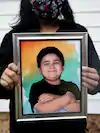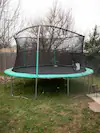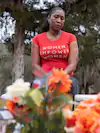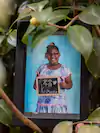Lastassija White and Quincy Drone lost their 5-year-old daughter to covid-19 in October. “I could tell she was really scared,” her father said of seeing Tagan in the emergency room after her death, her eyes still wide-open. (Photo by Cate Dingley for The Washington Post)
Priscilla Morse blames herself. “I had it last,” she said. “I was Gigi’s primary caregiver.”
Priscilla’s husband, David, blames himself. He brought the virus that causes covid-19 into the house after picking it up at the pool supply shop he manages.
Their 11-year-old son thinks it’s his fault: He’s the one who noticed his 6-year-old sister lying still, eyes open, blank stare. He called 911, but wonders if he couldn’t have noticed earlier.
The older kids believe they should have checked in on their sister sooner.
“They were happy, well-adjusted kids,” their mother says now. “Then, snap your fingers. They’re broken, in therapy, on meds. Struggling, a lot.”
Covid-19 killed Gigi Morse in August in Jackson, Tenn. She was a dynamo of a kid who loved Froot Loops and was obsessed with all things “Frozen” — the songs, the characters.
The virus didn’t kill anyone else in the Morse family, but Gigi’s mother says it might as well have. The pain does not ebb. The guilt gnaws at them constantly.
“You see on the news, ‘X amount of people died,’ but it’s so much more than that,” Priscilla said. “Do people see just how destroyed your family and your life is, six months later? Half-a-million families who’ve had their world torn apart?”
As the nation reaches the milestone of a half-million deaths about a year after the first American succumbed to the coronavirus, the number of children killed by the disease remains relatively small. The necropolis of covid has grown into a city of sorrow the size of Atlanta or Sacramento — a death toll larger than the combined American losses in combat from the Civil War, World War I and World War II, according to the Department of Veterans Affairs.
In this new national graveyard of virus victims, the section set aside for the young held 271 children as of early February, according to data from the American Academy of Pediatrics and the Centers for Disease Control and Prevention.
Each death represents a shattered family and a trauma deepened, parents say, by the rampant belief that kids can’t get covid, or that it doesn’t much harm them when they do.
The day before Gigi died, President Donald Trump said that children “are almost immune from this disease. … They don’t have a problem.”
Although relatively few children die of covid-19, “it’s not fair to say it’s a benign disease among children,” said Sean O’Leary, an immunization researcher at Children’s Hospital Colorado and vice chair of the American Academy of Pediatrics committee on infectious diseases. “For every one of these deaths, quite a few kids spend a long time in ICUs and suffer lingering effects.”
The children who have died of covid-19 are, even more than among adults, disproportionately children of color — about three-quarters of those who’ve succumbed to covid so far, according to CDC data.
They were kids who were obsessed with vampires and unicorns, thrilled by skateboarding and Mario Kart. They left behind stuffed animals worn raw with love, siblings who still wander into their rooms looking for them, and, next to one child’s tombstone, a little white concrete bench, bedazzled with pink rhinestones that spell out “Kim.”
They had futures in mind. In Gainesville, Fla., Kimmie Lynum was busy planning her 10th birthday party. J.J. Boatman, a 9-year-old in Texas, was thinking about his future; he wanted to be a policeman or maybe work at Taco Casa so he could bring tacos home every day. Tagan Drone, a 5-year-old in Amarillo, Tex., planned to be a mermaid for Halloween. Elizabeth English, a 12-year-old cheerleader in Arizona, was all about finding what would make people more beautiful; the equipment bag she carried was the plumpest on her squad because she stocked hair spray, gel and bobby pins for her teammates.
Like most kids, they probably had some extra protection against the coronavirus, possibly because their noses and throats contain fewer of the receptors that the virus binds to, or because of their more robust immune systems.
“Younger kids, 10 and under, are both less likely to get infected when exposed and less likely to spread the disease when infected,” O’Leary said.
Still, nearly 3 million children in the United States have tested positive for the coronavirus, about 12 percent of all cases, according to the American Academy of Pediatrics.
For some children, the extra protection wasn’t enough. Nor were extraordinary efforts by EMTs, doctors and nurses, who pumped and pressed and prayed long beyond each child’s last breath.
Child deaths amount to 0.2 percent of the U.S. total, and as of early this month, 10 states had suffered no child fatalities. One state that has had more than its share of pediatric cases is Tennessee, where 130,000 kids have gotten infected and seven have died, including Gigi Morse, whose mother called her “Gigi Pickles.”
White lifts Drone’s shirt to show the tattoo on his back of their daughter, Tagan. (Photo by Cate Dingley for The Washington Post)
Kimmie Lynum’s school picture rests beneath a tree outside her home in Hawthorne, Fla. No one knew the 9-year-old had covid until after she had died. (Nydia Blas for The Washington Post)
Elizabeth English loved climbing this tree at a park in her hometown of Payson, Ariz. The 12-year-old died of multisystem inflammatory syndrome, a rare condition that affects children exposed to the coronavirus. (Photo by Cassidy Araiza for The Washington Post)
J.J. Boatman’s father holds one of the 9-year-old’s favorite toys, a colorful ball. (Allison V. Smith for The Washington Post)
This Hot Wheels bicycle was one of J.J.’s gifts for his ninth birthday. (Allison V. Smith for The Washington Post)
Another of J.J.’s favorite possessions was “Baby,” his toy kitty cat. (Allison V. Smith for The Washington Post)
Elizabeth English’s bedroom in Payson, Ariz. (Cassidy Araiza for The Washington Post)
Elizabeth, a seventh-grader, loved making people feel beautiful. (Cassidy Araiza for The Washington Post)
“Everything she was about was to make others happy,” said Alesha Olsen, the Elizabeth’s eldest sister. (Cassidy Araiza for The Washington Post)
Quincy Drone stands alongside a unicorn toy that belonged to his daughter, Tagan. (Photo by Cate Dingley for The Washington Post)
Lastassija White holds a collection of Tagan’s hair bows. The 5-year-old had always been “perfectly healthy” before contracting covid-19, her mother said. (Photo by Cate Dingley for The Washington Post)
White and Drone kept only a few of Tagan’s things when they moved to a new home after her death, among them her stuffed owl and bottles of nail polish. (Photo by Cate Dingley for The Washington Post)
Kimmie’s table and a collection of her things, including the LOL doll she loved. Last July she became Florida’s youngest victim of covid-19. (Nydia Blas for The Washington Post)
Kimmie’s clothes remain neatly organized in her closet. (Nydia Blas for The Washington Post)
Kimmie’s bedroom is as it was when the fourth-grader died. (Nydia Blas for The Washington Post)
Magda Jean-Louis and Julie Tate contributed to this report.
















